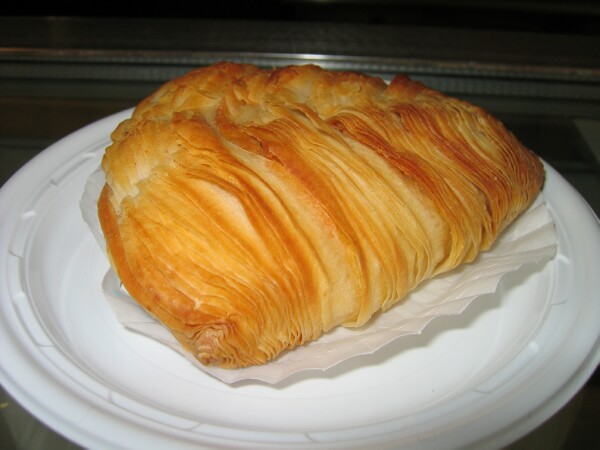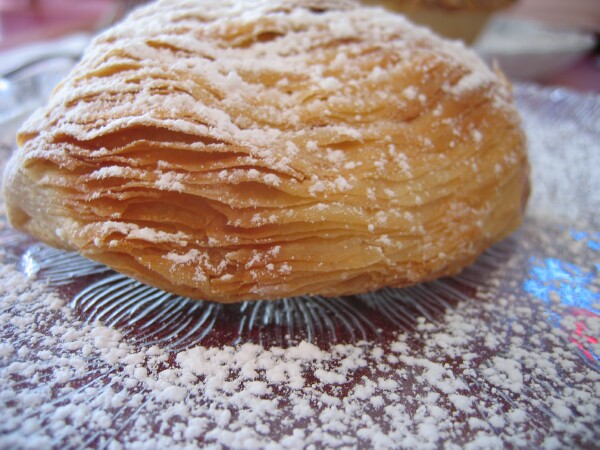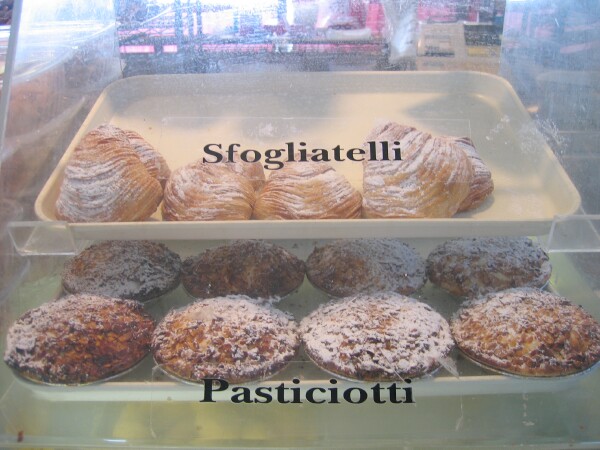Sfogliatelle in Chicago
Sfogliatelle in Chicago
-
-
-
-
-
Sfogliatelle in Chicago
-
Post #1 - December 7th, 2005, 2:18 amI realize this subject has been delved into before (2004), but I'm looking for a source of good sfogliatelle here in the Chicagoland region, or perhaps someone who knows how to make them could de-mystify their creative process for me. All those layers send chills down my spine when I contemplate following a recipe. Anybody out there actually make them and could give me some pointers?
I'd like to have some for the family by Christmas time when everybody's home. These pastries would really be a hit!
-
-
Post #2 - December 7th, 2005, 7:56 amArtemesia wrote:I realize this subject has been delved into before (2004), but I'm looking for a source of good sfogliatelle here in the Chicagoland region, or perhaps someone who knows how to make them could de-mystify their creative process for me. All those layers send chills down my spine when I contemplate following a recipe. Anybody out there actually make them and could give me some pointers?
I'd like to have some for the family by Christmas time when everybody's home. These pastries would really be a hit!
Should this perhaps be in Shopping & Cooking?
'Ueh, paesana:
Sfogliatelle, when well made, are sublime and without doubt one of the glories of the Italian -- nay, European -- world of pastries. I have never made them myself but must add that I have never known or heard of a home cook who made them, either in my extended family or among the families of friends, either back east (Jersey/New York) or in Italy.*
In Campania, there are, not surprisingly, lots of pasticcerie that turn out excellent sfogliatelle and in New York and New Jersey there are fewer pastry shops that do so but still a sufficient number to render it not too arduous a task to find sfogliatelle worthy of a holiday table. Here in Chicago, as discussed in that thread started by Mike G some time back, there don't seem to be any that are up to the level of the Campanian or the better of the New Netherlandish offerings. I haven't done a survey of all the pasticcerie in Chicagoland but judging from my own experiences and those of others, it just doesn't seem to be an item that is especially common or popular or well-done around here.
But were I you, I would -- and I myself will do the same -- inquire at some of the pasticcerie of decent reputation and find out if and when they make them. I'd then make an effort to try them in as fresh a state as possible, since part of the problem with examples I've tried around here is that they weren't maximally fresh, and this is not a pastry that survives well past 24 hours and is best eaten within about 10-12 of the making (better still within a couple of hours). Anyway, since Amata and I thought one we tried from Ferrara's on Taylor Street wasn't too bad, I would like to check with them and see if I can get one that is very fresh and see how it is. Maybe they could then be ordered fresh for 24 Dec.
Statte buon',
Antonius
*For one thing, it's a lot of work to get the many thin layers of dough made just right. The process, as I understand it, involves rolling dough out thin, painting it with lard, rolling it up and then stretching it out further... But as I said, I've never seen it done in a home kitchen and don't have much of a sense of how difficult it really is.Alle Nerven exzitiert von dem gewürzten Wein -- Anwandlung von Todesahndungen -- Doppeltgänger --
- aus dem Tagebuch E.T.A. Hoffmanns, 6. Januar 1804.
________
Na sir is na seachain an cath.
-
-
Post #3 - December 7th, 2005, 8:29 amAntonius wrote:Anyway, since Amata and I thought one we tried from Ferrara's on Taylor Street wasn't too bad
Antonius,
I quite like the Sfogliatelle at Ferrara's.
But thought the Sfogliatelle I had earlier this year at Vaccaro's in Baltimore winner on points.
Vaccaro's Sfogliatelle

Enjoy,
Gary
Ferrara Bakery
2210 W Taylor
Chicago, IL 60612
312-666-2200
-
-
Post #4 - December 7th, 2005, 8:34 amThe best I've tried locally have been at Palermo Bakery on Harlem. The problem is that not every time at Palermo are they "the best", and by that I mean sublime or really good. Other sources, including Caputo's and Il Giardino both also on the Harlem Little Italy stretch, Ferrara mentioned above, and Claudio's near Johnnies Italian beef on North Av., make these pastries that never rise beyond good*. I'll never buy the New York pizza or the New York hot dog arguments, but for sfog's, only Palermo on a good day has come close to what I've had in New Amsterdam.
*Sfogliatelle being one of those things that even average can still be a good thing to eat.Think Yiddish, Dress British - Advice of Evil Ronnie to me.
-
-
Post #5 - December 7th, 2005, 9:24 amArtemesia,
You may have seen this already in your search, but sfogliatelle are available at Doughboys Bakery in Shorewood (is that sort of near where you are?). According to Chowhound poster Mugs, the owners of Doughboys are related to the Lezzas of Bellwood, another bakery where you can get sfogliatelle.
Not at all near you, unfortunately (but I'll mention it anyway), is Il Mulino in Highwood, which also makes sfogliatelle.
As Antonius said, getting the pastries as fresh as possible is crucial. Good luck with your search.
Amata
p.s. did you make that gelatina de leche? how did it turn out?
Doughboys Bakery
852 Sharp Drive Unit E
Shorewood, IL 60431
LEZZA SPUMONI & DESSERTS, INC.
4001-09 St. Charles Rd.
Bellwood, Illinois 60104
(708) 547-5969
http://lezza.com/
Il Mulino Bakery
530 Sheridan Road
Highwood, IL 60040
847-266-0811
-
-
Post #6 - December 7th, 2005, 9:40 amHI,
Over in this thread, Erik M offered homemade Thai kàrìi "puffs" which had a chicken curry filling. Not your Italian sfogliatelle though visually quite similar:


Regards,Cathy2
"You'll be remembered long after you're dead if you make good gravy, mashed potatoes and biscuits." -- Nathalie Dupree
Facebook, Twitter, Greater Midwest Foodways, Road Food 2012: Podcast
-
-
Post #7 - December 7th, 2005, 9:55 amCathy2 wrote:HI,
Over in this thread, Erik M offered homemade Thai kàrìi "puffs" which had a chicken curry filling. Not your Italian sfogliatelle though visually quite similar
Cathy, the "puffs" are exactly what I thought of when I saw those pictures of sfogliatelle. I was the eager recipient of a couple, and they were amazing. Wishing I could pop next door to the thai curry puffs store...
-
-
Post #8 - December 7th, 2005, 10:00 amkl5 wrote:Wishing I could pop next door to the thai curry puffs store...
Me, too!Cathy2
"You'll be remembered long after you're dead if you make good gravy, mashed potatoes and biscuits." -- Nathalie Dupree
Facebook, Twitter, Greater Midwest Foodways, Road Food 2012: Podcast
-
-
Post #9 - December 7th, 2005, 10:09 pmI've made some progress today. I consulted Nick Malgieri's Great Italian Desserts and Antonius is right on the money when he suggests all the layers must be rolled very thin and painted with lard. But Malgieri uses a pasta machine to do the "rolling out" of the dough into a thin layer, which is then painted with a mixture of both butter and lard and then rolled up tightly. This roll of dough and lard is then cut into slices which are then pushed out gently from the center until they each form the shell shape. These are then baked and filled with the ricotta filling.
While Malgieri admits that this process is labor intensive, he suggests to spread it out over four days by making the dough the first day, forming the dough/lard roll the next, making the filling the third day, and finally putting it all together and baking and filling them on the fourth -- which seems like it is within the realm of a do-able kitchen project IF you have a pasta machine, which I do not, unfortunately. But perhaps I can borrow one or ask Santa for one for Christmas...
I have to admit, when I saw those photos, Antonius, I got absolutely weak in the knees. They are like miniature works of art. So beautiful!
As far as going to the city in search of them, I might attempt a trip to Ferrara's when the Great Freeze outdoors lessens. Our only local source of Italian food supplies, The Italian Specialty Shop, has closed its doors here forever, and my pantry badly needs replenishing. So thanks to all for the suggestions. (Amata: Shorewood is waaaaaay west, past Joliet. I'm straight south as the bird flies from the Loop. Also, I still haven't had a chance to make the gelatina, but I plan on doing so soon. I decided not to make it for Thanksgiving because it was an unknown entity and I was afraid it might flop. But it's coming. Thanks for asking!)
Cathy2: those karii puffs really do look like like sfogliatelle. Going back to my days in Anthro, maybe this is a case of cultural diffusion?? They do look delicious though!
They do look delicious though!
-
-
Post #10 - December 8th, 2005, 9:15 amInspired (shamed, really) by Bill/SFNM's command of baking fundamentals, as evidenced by a delicious focaccia he made, I resolved to learn a few things about how better to use my own ovens. In response to a question from Bill on sfogliatelle, I did a little research on how to make them.
There are two basic forms of sfogliatelle: lisce (smooth) and ricce (curly). In Naples, the two forms are further divided into specialties of local bakers or convents (where sfogliatella in its current form was invented) such as munachine (little nuns) or coda d’aragosta (lobster tail). The lisce are made with pasta frolla (short pastry) and are of a kind any competent amateur cook might make at home. Ricce (a phyllo pastry) are typically left to professionals or talented amateurs because of the skill and labor intensity. I tracked down every Italian I know who bakes well, and they all thought I was nuts to want to make sfogliatelle ricce at home when I could buy perfectly fine examples nearby for a few bucks. NB: They also thought I was crazy to cure my own guanciale: who’s laughing now.
The filling is the same for both lisce and ricce. It’s pretty easy and I found only a little variation from recipe to recipe. Some bakeries offer an alternative filled with a custard, but I prefer this filling.
Filling
3 Cups milk
Salt
6 ounces semolina
6 ounces Ricotta, drained There is currently good imported ricotta at Whole Foods
12 ounces superfine sugar
Cinnamon
1 tsp orange extract (you may need to experiment to get the right amount)
2 Tbs candied orange peel or citron in a small dice
3 large eggs (I tried it with 4 small eggs and like it with the extra yolk)
As the milk starts to boil, add pinch of salt and all the semolina, stirring constantly. Cook low about 7-10 minutes. Transfer to a bowl to let cool for an hour or so. Mix ricotta, sugar, citron, and eggs in a large bowl, then combine with cooled semolina.
Pastry (pasta frolla)
3.5 Cups unbleached flour
¾ cup sugar
6 ounces lard or butter at room temperature
.5 C cold water, maybe less
Salt
Zest of 1 lemon
1 large or two small egg yolks
Using the “well method,” add sugar, lard, water, salt, lemon peel, and egg yolk to a mound of flour. Mix together and form into a ball with as little kneading as possible. Wrap in plastic wrap and leave in refrigerator for an hour or so.
For each sfogliatella, use about 3 ounces of dough, rolled into a circle. Put stuffing on pastry (2-3 Tbs?), stretching the pastry over the stuffing and sealing with a pastry cutter. Bake for 15 minutes or so at 375 degrees.
Here is Mario Batali’s version: http://www.foodnetwork.com/food/recipes ... 84,00.html
Pastry (ricce)
2 Cups unbleached all purpose flour
2 cups bread flour
1 tsp honey
Salt
1.5 C cold water.
Plus, one Cup lard or butter melted
Combine flours and arrange in a mound. Add honey, salt, and water to well and milk with a fork, gradually combining until all but .5 C of flour is used up. Knead dough by hand until all flour is absorbed and dough is smooth and elastic (5ish minutes). Wrap dough in plastic and refrigerate for 2 hours.
Divide dough into 4 pieces and pass through a pasta machine to stretch each piece into a thin layer (finish at the last setting on the pasta machine). Cut each sheet into about 18 inch lengths. Place a sheet of pastry on a sheet of parchment and brush with melted lard. Add another sheet on top and brush it with lard, repeating until all sheets are used. Roll the layered pastry tightly from the 6ish inch end into a single roll. Wrap in a damp dish town and refrigerate for 4 hours or more.
Cut the rolled pastry (half inch or so) into a slice and push gently out from the center to make a cone. Try to displace the layers equally and flatten until the pastry looks sort of clamshell-like. Stuff, put on a cookie sheet and brush each pastry with a little lard. Bake at 375 for about 15 minutes, or until nicely browned. Top with powdered sugar and serve.
Variation: Coda d’aragosta
Make a ricce pastry shell, but stretched out longer, then stuff it with a dowel shaped piece of pasta bomboloni (leavened pastry dough). When you bake it, the leavened dough expands and separates the layers of phyllo. Pipe this with whipped and sweetened heavy cream after it is baked.
After the results of my assiduous investigation into making sfogliatelle, I'm still buying them from Palermo Bakery.
"Napule tre cose tene belle...
o' mare
o' vesuvio
e e' sfugliatelle"
-
-
Post #11 - December 8th, 2005, 9:22 amChoey wrote:There are two basic forms of sfogliatelle: lisce (smooth) and ricce (curly). In Naples, the two forms are further divided into specialties of local bakers or convents (where sfogliatella in its current form was invented) such as munachine (little nuns) or coda d’aragosta (lobster tail). The lisce are made with pasta frolla (short pastry) and are of a kind any competent amateur cook might make at home. Ricce (a phyllo pastry) are typically left to professionals or talented amateurs because of the skill and labor intensity. I tracked down every Italian I know who bakes well, and they all thought I was nuts to want to make sfogliatelle ricce at home when I could buy perfectly fine examples nearby for a few bucks. NB: They also thought I was crazy to cure my own guanciale: who’s laughing now.
Thanks for the details!
One thing I see a lot at local bakeries is that "lobster tails" are used for the pastry with custard/pastry cream and sfogs have a creamier filling, not quite canolli, not quite whipped cream. (I think, I may have it reversed).
RobThink Yiddish, Dress British - Advice of Evil Ronnie to me.

